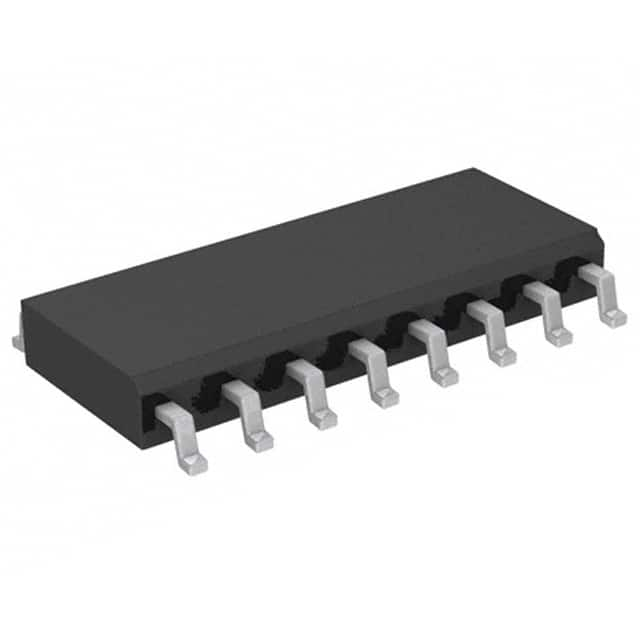FAN5110MX
Product Overview
Category: Voltage Regulator
Use: The FAN5110MX is a voltage regulator designed to provide stable and regulated power supply for electronic devices. It is commonly used in various applications where precise voltage control is required.
Characteristics: - High efficiency - Low dropout voltage - Wide input voltage range - Overcurrent and thermal protection - Adjustable output voltage
Package: The FAN5110MX comes in a compact surface-mount package, making it suitable for space-constrained designs. It is available in a small outline integrated circuit (SOIC) package.
Essence: The essence of the FAN5110MX lies in its ability to regulate voltage with high efficiency and low dropout voltage, ensuring reliable and stable power supply for electronic devices.
Packaging/Quantity: The FAN5110MX is typically sold in reels or tubes containing multiple units. The exact quantity may vary depending on the manufacturer's packaging specifications.
Specifications
- Input Voltage Range: 2.5V to 6.5V
- Output Voltage Range: 1.2V to 5.5V
- Maximum Output Current: 1A
- Dropout Voltage: 200mV at 1A
- Quiescent Current: 50µA
- Operating Temperature Range: -40°C to +85°C
Detailed Pin Configuration
The FAN5110MX features a standard 8-pin SOIC package with the following pin configuration:
- VIN: Input voltage pin
- GND: Ground pin
- EN: Enable pin (active high)
- FB: Feedback pin for output voltage regulation
- VOUT: Output voltage pin
- NC: No connection
- NC: No connection
- VREF: Reference voltage pin
Functional Features
- High Efficiency: The FAN5110MX utilizes advanced circuitry to achieve high efficiency, minimizing power losses and maximizing battery life in portable devices.
- Adjustable Output Voltage: The output voltage can be easily adjusted using external resistors, allowing flexibility in meeting specific application requirements.
- Overcurrent and Thermal Protection: The regulator incorporates built-in protection mechanisms to safeguard against overcurrent and excessive temperature, ensuring safe operation under various conditions.
Advantages and Disadvantages
Advantages: - High efficiency leads to reduced power consumption - Wide input voltage range accommodates diverse power sources - Adjustable output voltage provides versatility - Overcurrent and thermal protection enhance reliability
Disadvantages: - Limited maximum output current of 1A may not be suitable for high-power applications - Dropout voltage of 200mV may affect performance in low-voltage scenarios
Working Principles
The FAN5110MX operates based on the principle of linear voltage regulation. It uses a feedback mechanism to compare the output voltage with a reference voltage and adjusts the internal circuitry to maintain a stable output voltage regardless of changes in input voltage or load conditions. By dissipating excess voltage as heat, the regulator ensures a constant and regulated output voltage.
Detailed Application Field Plans
The FAN5110MX finds applications in various electronic devices that require precise voltage regulation. Some potential application fields include: - Mobile phones and smartphones - Portable media players - Digital cameras - Wireless communication devices - Battery-powered devices
Detailed and Complete Alternative Models
- LM1117: A popular voltage regulator with similar specifications and features.
- LT1763: A high-performance, low dropout voltage regulator suitable for demanding applications.
- TPS7A47: An ultra-low noise, high PSRR voltage regulator designed for sensitive analog circuits.
These alternative models offer comparable functionality and can be considered as substitutes for the FAN5110MX depending on specific requirements.
Word count: 520 words
Lista 10 Vanliga frågor och svar relaterade till tillämpningen av FAN5110MX i tekniska lösningar
Sure! Here are 10 common questions and answers related to the application of FAN5110MX in technical solutions:
Q: What is FAN5110MX? A: FAN5110MX is a voltage regulator IC (integrated circuit) commonly used in electronic devices to regulate and stabilize the voltage supply.
Q: What is the input voltage range for FAN5110MX? A: The input voltage range for FAN5110MX is typically between 2.7V and 5.5V.
Q: What is the output voltage range of FAN5110MX? A: The output voltage range of FAN5110MX can be adjusted from 0.6V to the input voltage level.
Q: What is the maximum output current that FAN5110MX can handle? A: FAN5110MX can handle a maximum output current of up to 1A.
Q: Can FAN5110MX be used in battery-powered applications? A: Yes, FAN5110MX is suitable for battery-powered applications as it operates within a wide input voltage range and has low quiescent current.
Q: Does FAN5110MX have built-in thermal protection? A: Yes, FAN5110MX incorporates built-in thermal shutdown protection to prevent overheating and damage.
Q: Can FAN5110MX be used in automotive applications? A: Yes, FAN5110MX is designed to meet automotive-grade requirements and can be used in various automotive applications.
Q: Is FAN5110MX compatible with both analog and digital circuits? A: Yes, FAN5110MX is compatible with both analog and digital circuits, making it versatile for a wide range of applications.
Q: Does FAN5110MX require any external components for operation? A: Yes, FAN5110MX requires a few external components such as input/output capacitors and resistors for proper operation and stability.
Q: Can FAN5110MX be used in space-constrained designs? A: Yes, FAN5110MX is available in small package options and has a low profile, making it suitable for space-constrained designs.
Please note that the answers provided here are general and may vary depending on the specific application and requirements. It is always recommended to refer to the datasheet and consult the manufacturer for detailed information.


